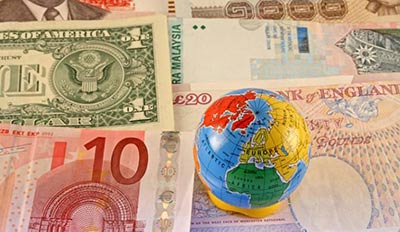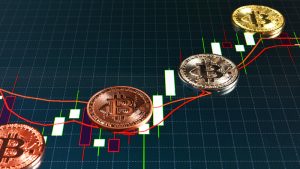Live Currencies

According to the UN (United Nations), there are 180 different recognised currencies, which are used across 195 countries in the world. However, as many as 66 different countries have their own exchange rate in one way or another linked to the US dollar exchange rate or use the US dollar (USD) as their currency. In some countries, both the national currency but also US dollars are used, either for tourists or as a complement to their own currency. Forex trading in both sterling pounds (GBP) and the dollar often stands for stability, while some smaller national currencies can be very volatile.
Click on a flag below to see live rates and get more facts, or hold the mouse pointer over a flag to see which country’s currency that is being described..
Table of Contents: Overview
- 1 The most traded currency pairs
- 2 Currency pairs at different brokers
- 3 What is a currency pair and how can you make money on these?
- 4 Which currency pair should you trade with in Great Britain?
- 5 Majors: The biggest currency pairs
- 6 Minors: A few smaller currency pairs
- 7 What is exotic currencies?
- 8 What is a currency cross?
- 9 Volatile currency pairs
- 10 Nick names in the forex market
- 11 Crypto currencies
The most traded currency pairs
Currency pairs at different brokers
Some currency brokers don’t have all currencies available for trading. Therefore, it can be worthwhile to do your homework before starting your forex trading. Here, we make sure to cover all currency pairs that’s available at various forex brokers and make sure that you can see it clearly from each review.
Our currency section lets you become familiar with the different major currencies and currency pairs that are traded around the world. The more popular a currency is, the higher volumes are traded and then the so-called spread is usually smaller – the difference between the buying and selling price. Trading in major currency pairs is great because it means that the exchange rate needs to move less in the right direction before you can make a profit.
To facilitate your decision to choose a currency broker, we state in our reviews of the brokers which currency pairs are offered by each broker [2 gånger samma sak, var ta bort????]. But first let’s start with what a currency pair is.
What is a currency pair and how can you make money on these?
Trading in the foreign exchange market, usually referred to as “forex trading”, is by far the largest regulated financial market in the world in terms of cash value.
Our currency trading article about the size of the market according to BIS describes more about volumes, where people trade and how they trade. The foreign exchange market includes trading between major banks, central banks, currency speculators and foreign exchange investors, multinational companies, governments, other financial markets, institutions and other entities. Forex traders simultaneously buy one currency and sell another and currencies are always priced and traded in pairs, so-called currency pairs. There is not a single and central physical exchange where forex transactions occur because currency trading is carried out freely between counter-parties, in person, by telephone or online.
According to research from South Africa, the most volatile currency pairs such as ZAR, often offer attractive profit opportunities because their price movements can be more dramatic than less volatile pairs. The same study shows that although increased volatility can provide more room to realise a profit, it can also increase a trader’s risk exposure. Like always, higher upside usually also mean higher risk level.
In general, volatile fx pairs are affected by the same driving forces as their less volatile counterparts, which may include interest rate differentials, geopolitics, the perceived economic strength of the currency issuing country and the value of these nations’ imports and exports. Forex traders need to remember that volatile currency pairs often have lower liquidity levels than their less volatile counterparts. A well-thought-out trading plan and risk management strategy is the key. Based on the average daily trading volume and liquidity, a distinction is normally made between: Majors, minors and exotic currency pairs.
Which currency pair should you trade with in Great Britain?
For us Brits, it may, at least initially, be easiest to trade with a currency pair that you know the exchange rate for, such as GBP/EUR, GBP/USD or GBP/JPY. Since exchange rates are also linked to both political decisions, national events or the economy in a specific country, it can also make it easier to trade with the currency in the country you live in, as you often have a sense of the market situation and naturally follow events in the country. If you believe that the Swedish economy will be stronger, the country is doing well, companies are delivering good results and the like, the currency (in our case GBP) will often be stronger in the long run, ie you need fewer Swedish kronor to trade the foreign currency. Our tip is also to try to choose a currency broker who has GBP as the base currency in the account, if you believe in the British pound. Otherwise, you might as well have EUR or USD to trade with in your currency trading account.
Majors: The biggest currency pairs
The most traded currency pairs in the world are called majors. The world’s most traded currencies account for slightly over 85% of all daily forex trading on average. This group includes currencies such as the Euro, the US dollar, the Japanese yen, the pound sterling, the Australian dollar, the Canadian dollar and the Swiss franc. The major currency pairs can also be traded the other way around, if it suits the currency trader’s market beliefs better. Of these currencies, the US dollar accounts for the largest volume (42.5 percent), the euro has a market share of 19.6 percent, the Japanese yen accounts for 9.6 percent of trade, while the pound stands at 6.5 percent. The Australian dollar accounts for 3.9 percent and the Swiss franc has a market share of 3.7 percent. With its 2.6 percent share, the Canadian dollar is the tiniest of the majors on the forex market. Here is an overview of majors, where the following 6 currencies are counted as the largest:
EUR/USD – Euro/US dollar.
USD/JPY – US dollar/Yen.
GBP/USD – British pound sterling/US dollar.
AUD/USD – Australian dollar/US dollar.
USD/CHF – US dollar/Swiss franc.
USD/CAD – US dollar/Canadian dollar.
Men ibland tas även USD/NZD med. Detta anser vi dock vara felaktigt då trading volymen är relativt låg för valutaparet. Nya Zeeland har för övrigt knappt 5 miljoner invånare.
Minors: A few smaller currency pairs
Mindre valutapar eller “minors” som det kallas på engelska, består aldrig av USD. De mindre valutaparen handlas mindre aktivt än majors, även om deras ekonomier fortfarande är betydande och de tenderar också att vara aktiva i internationell handel. Här återfinns till exempel de svenska och norska kronorna, den nya zeeländska dollarn etc. Många av dessa, men inte alla, är valutor i länder som har ett starkt beroende av råvaror. Dessa valutor kallas ofta för råvaruvalutor eller commodity currencies. I denna grupp är Hong Kong dollarn störst med en marknadsandel på 1,2 procent. Därefter följer den svenska kronan, 1,2 procent, New Zealand dollar (0,8 procent), den sydkoreanska wonen KRW ₩ (0,75 procent), Singapore dollarn (0,7 procent), den norska kronan (0,65 procent), den mexikanska peson (0,65 procent). Minst i denna grupp är den indiska rupien med en marknadsandel på 0,45 procent. Resterande del av marknaden, 6,1 procent, utgörs av handel i så kallade exotiska valutor. Några exempel på minors är och inkluderar par såsom EUR/GBP, EUR/SEK, EUR/NOK, EUR/AUD, EUR/CHF eller GBP/JPY. Ifall du inte vill vara exponerad mot dollar på grund av att du är osäker på hur det kommer gå där, så kan det vara en bra idé att satsa på några av de lite mindre valutaparen.
What is exotic currencies?
Exotic currency pairs consist of even less traded pairs, such as emerging markets or smaller economies, against the USD or EUR. Examples of exotic currencies that are popular with Swedes are mainly USD/SEK, EUR/SEK, SEK/NOK, EUR/NOK, USD/CNY and USD/NOK. Chinese Yuan is probably the most exotic currency that will become the most important over the years, as China is about to become the world’s largest economy in just a few years. By the way: The reason that Danish kroner (DKK) is not included is traded so diligently is because the country has a more or less fixed exchange rate against the Euro. Some examples of the most traded exotic currencies include Russian rubles, Turkish lira and Brazilian reals. Some of the most popular exotic currencies are:
USD/TRY – US dollar/Turkish lira
EUR/TRY – Euro/Turkish lira
USD/ZAR – US dollar/South African rand
EUR/ZAR – Euro/South African rand
USD/CNY – US dollar/Chinese Yuan
USD/INR – US dollar/Indian Rupee
USD/MXN – US dollar/Mexican peso
USD/SGD – US dollar/Singaporean dollar.
What is a currency cross?
Currency pairs that are not traded against the dollar are called “currency crosses” or simply “crosses”. All currency pairs involving the euro are usually called “Euro Crosses”.
GBP/CAD – British pound/Canadian dollar
GBP/CHF – British pound/Swiss franc
GBP/JPY – British pound/Japanese Yen
GBP/NZD – British pound/New Zealand dollar
GBP/AUD – British pound/Australian dollar
CAD/JPY – Canadian dollar/Japanese Yen
AUD/JPY – Australian dollar/Japanese Yen
AUD/CAD – Australian dollar/Canadian dollar
AUD/NZD – Australian dollar/New Zealand dollar
AUD/CHF – Australian dollar/Schweizerfranc
NZD/JPY – New Zealand dollar/Japanese Yen
CHF/JPY – Swiss Franc/Japanese Yen
etc.
Euro Crosses
EUR/CHF – Euro/Swiss Franc
EUR/JPY – Euro/Yen
EUR/GBP – Euro/British pound
EUR/CAD – Euro/Canadian dollar
EUR/AUD – Euro/Australian dollar
EUR/NZD – Euro/New Zealand dollar
Volatile currency pairs
The most volatile currencies are those that may give a trader the greatest opportunity to make money, as these are the ones that tend to move more. However, as they are more volatile, this also means that the risk increases, so be careful.
AUD/JPY
NZD/JPY
GBP/EUR
CAD/JPY
GBP/AUD
USD/ZAR
USD/KRW
USD/BRL
USD/TRY
USD/MXN.
Nick names in the forex market
Currency pairs and currencies are often referred to by nicknames of traders rather than their symbolic nomenclature. Below are some common examples:
Nick names for currencies
Australian dollar (AUD) – Aussie
British pound (GBP) – Cable / Sterling
Canadian dollar (CAD) – Loonie
New Zeeland dollar (NZD) – Kiwi
Swiss Franc (CHF) – Swissy
U.S. dollar (USD) – Buck/Greenback
Nick namnes for currency pairs
GBP/USD (British Pound/US Dollar) Cable
EUR/USD (Euro/US Dollar) Euro or Fiber
USD/CHF (Swiss Franc/US Dollar) Swissy
USD/CAD (US Dollar/ Canadian Dollar) Loonie
AUD/USD (Australian Dollar/US Dollar) Ozzie
EUR/GBP (Euro/British Pound) Chunnel
Crypto currencies
Crypto currencies, also called virtual currencies or digital currencies, are the new type of currencies that are traded completely digitally.
Some examples of Crypto currencies is Bitcoin, Ethereum, Ripple, Dash and Bitcoin Cash.
Crypto currencies are available digitally, traded and commonly used on computers or mobile phones. However, the cryptocurrencies are represented with their own symbols or logos, which can also appear in physical form printed on their own issued coins either as collector’s items or merely symbolically. These therefore usually have no value in themselves or a connection to the real, digital currency.
Who owns which digital coins and how much, is usually controlled through a decentralized database, distributed over the network’s users where so-called block chain technology keep track of transactions. Some virtual currencies such as Bitcoin and Ethereum, is based on a centralized technology where the data on who owns what is not decentralized.




























